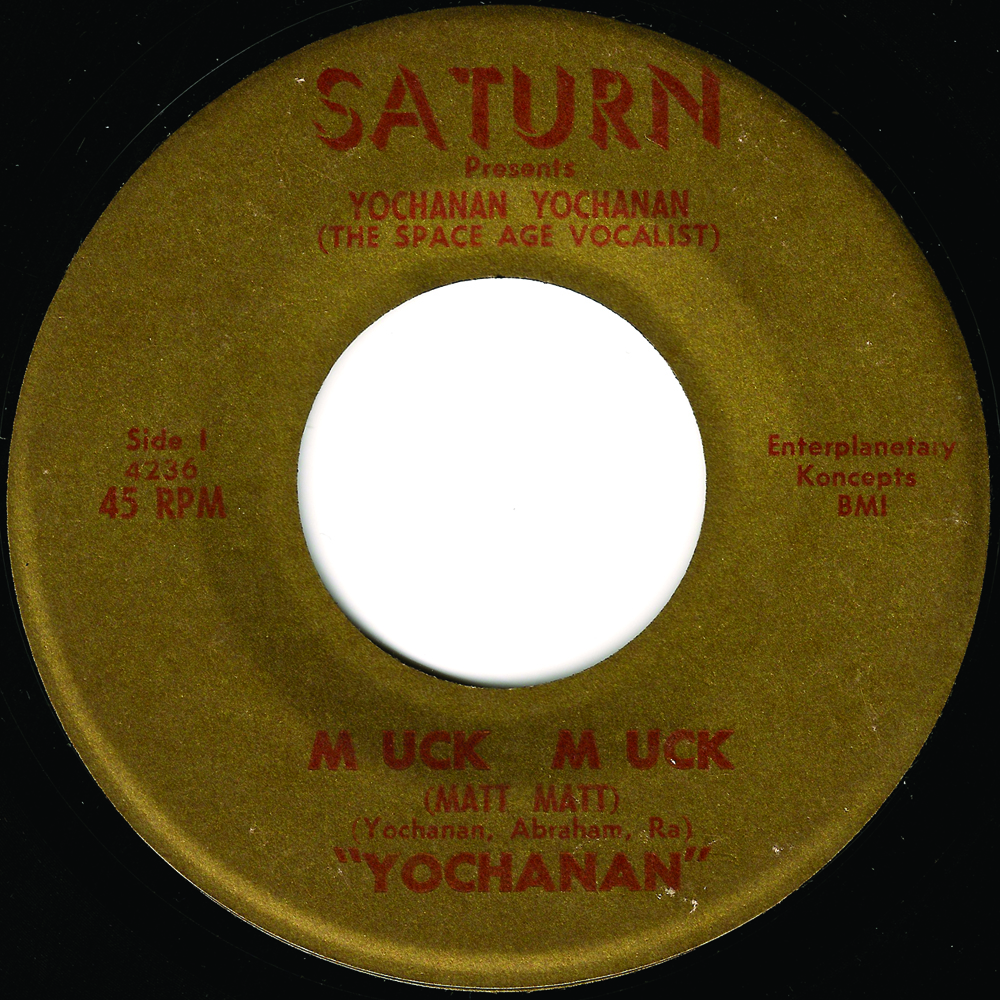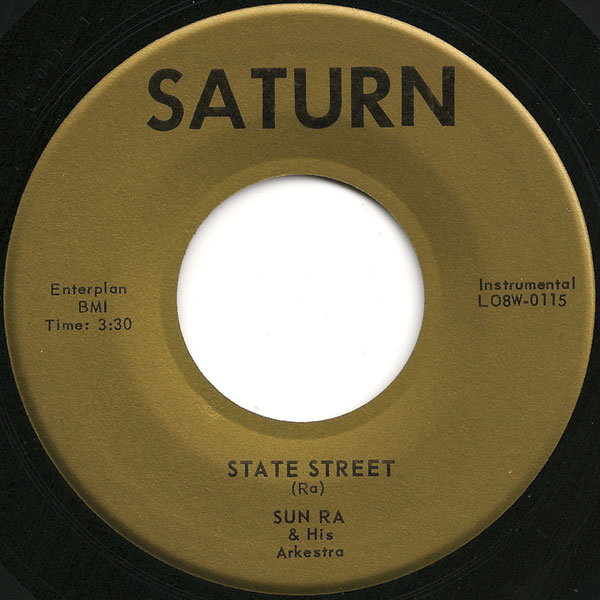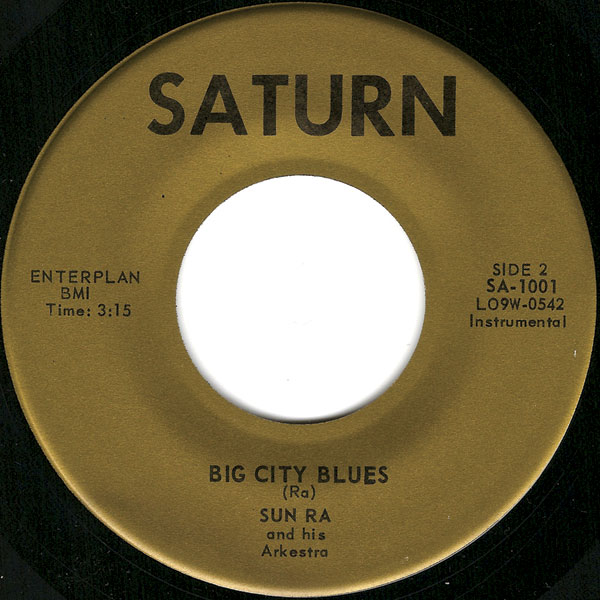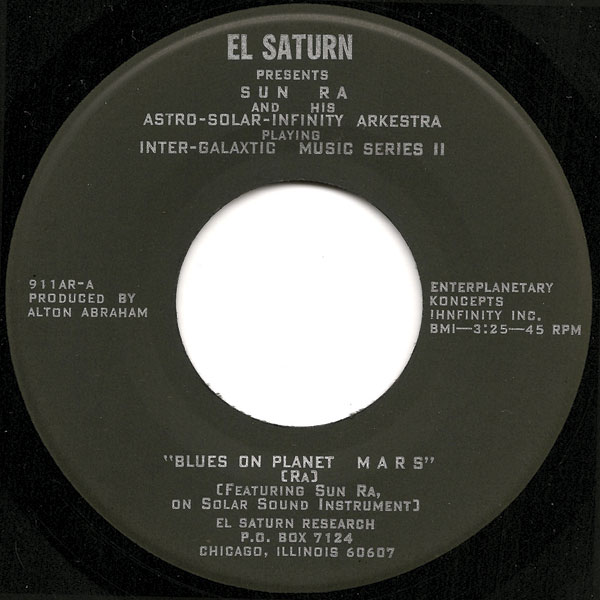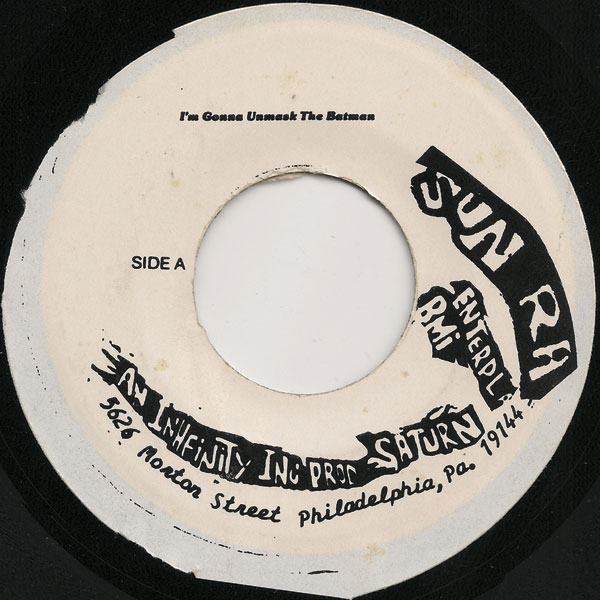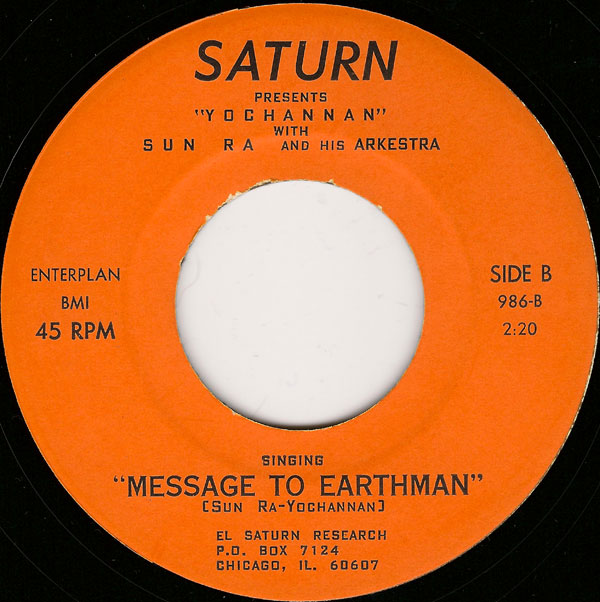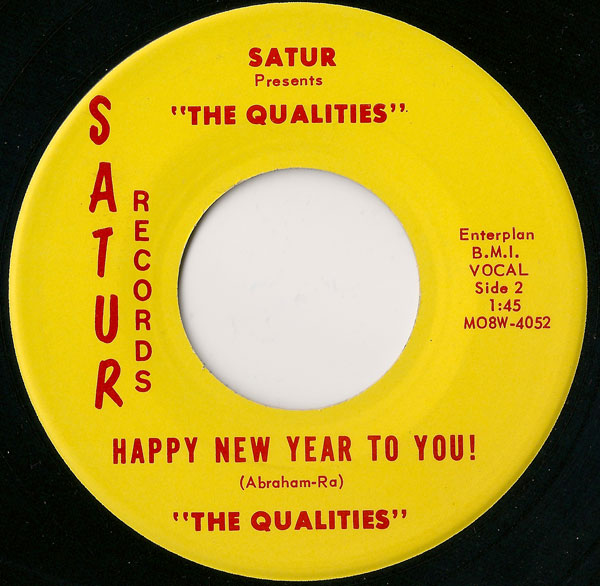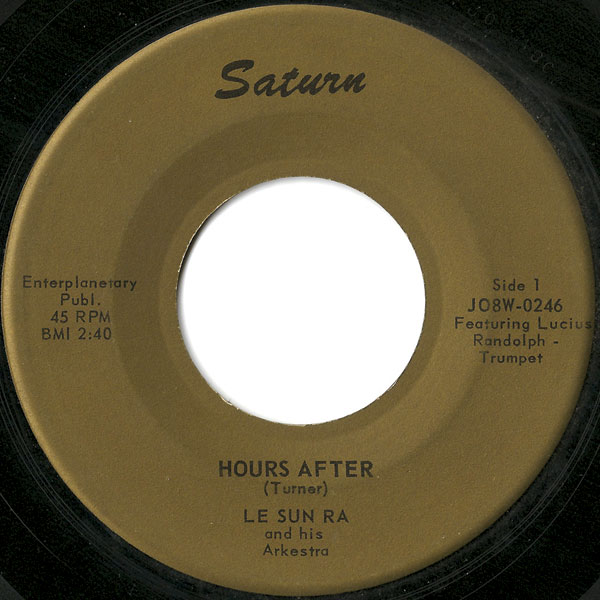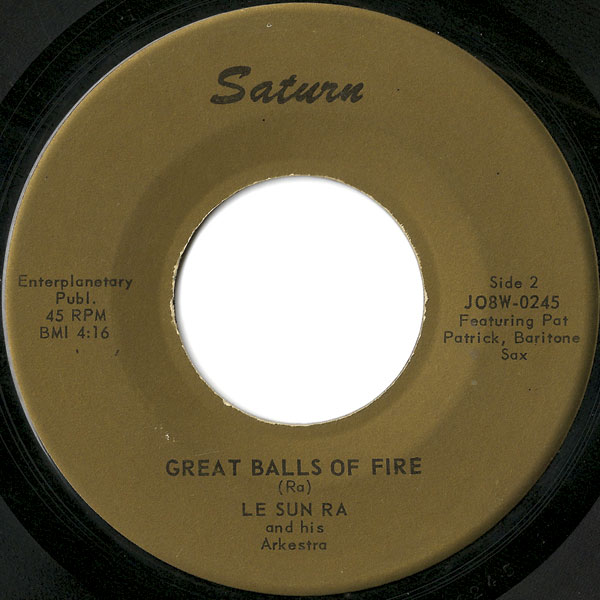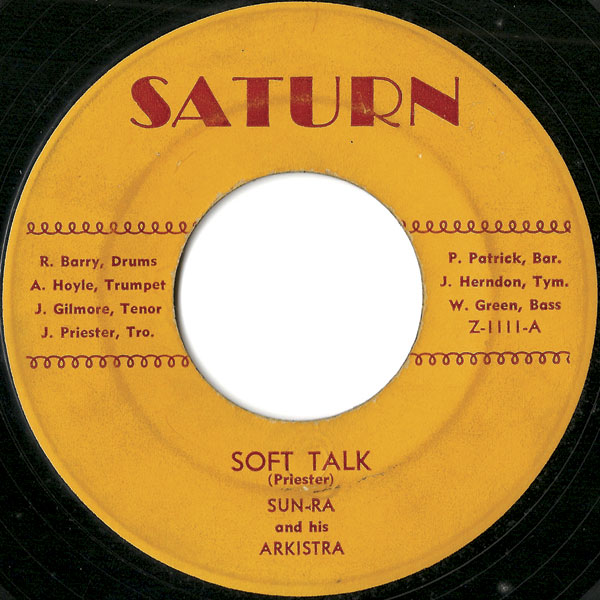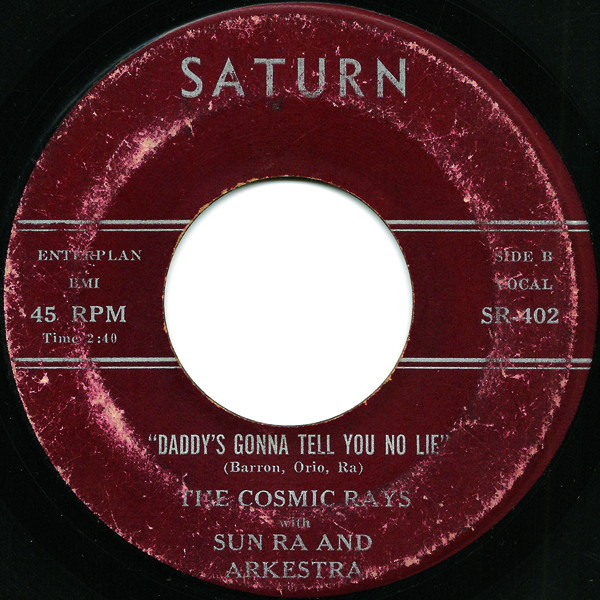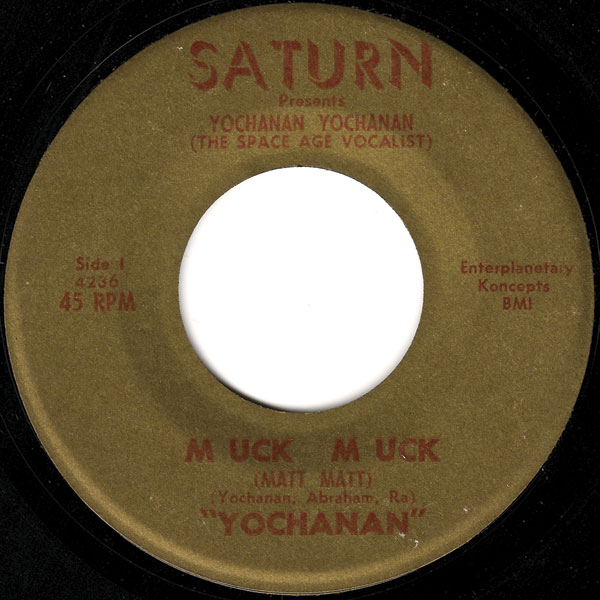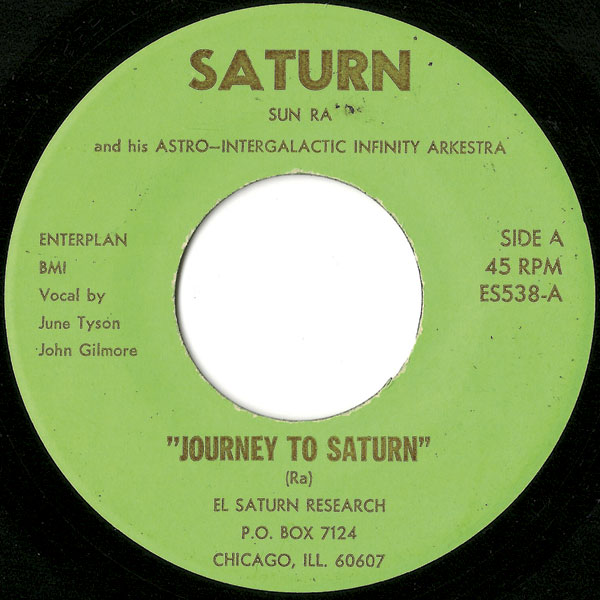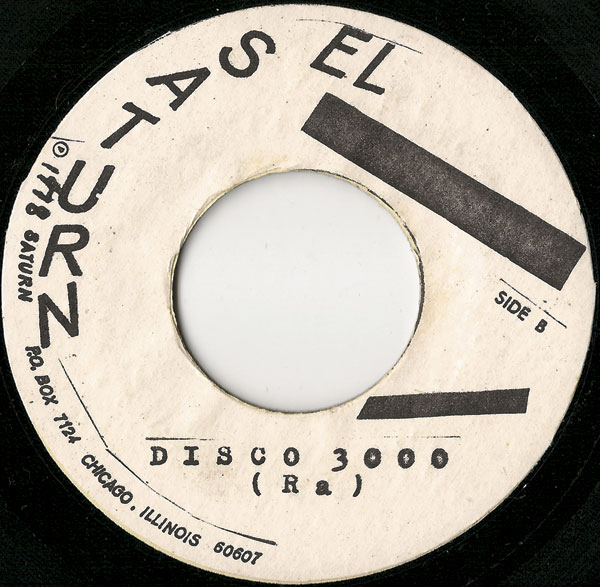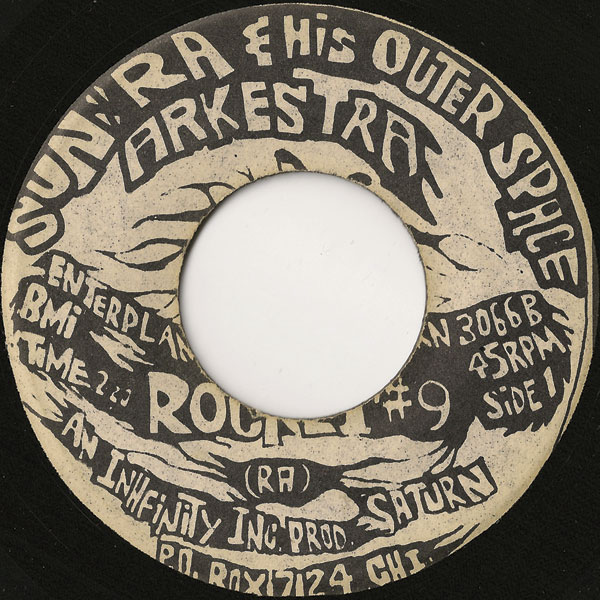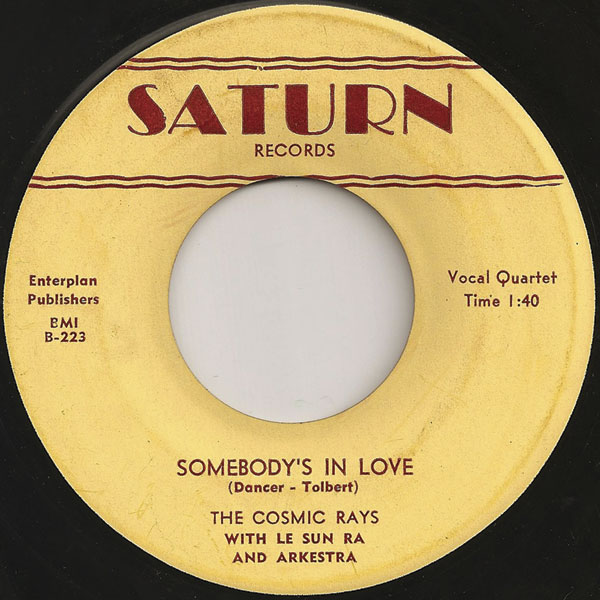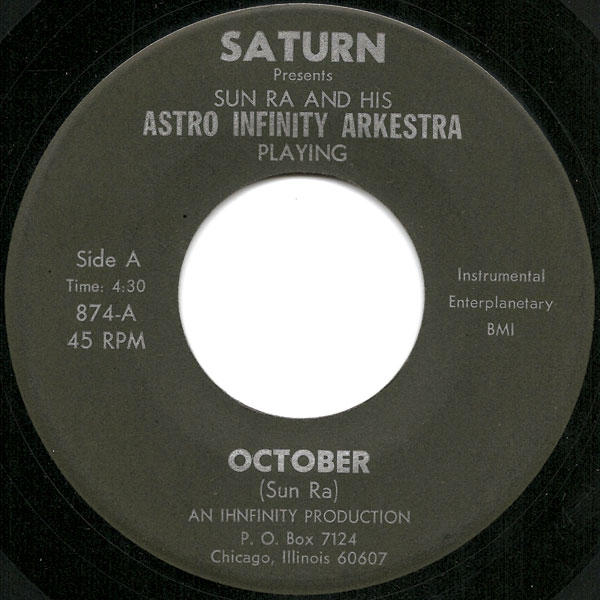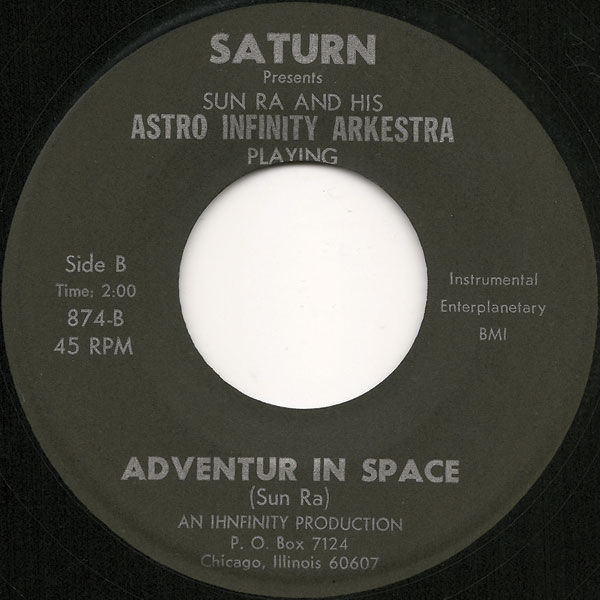
Lights From A Satellite: The Sun Ra Singles
At the centre, the Sun: celestial fire, solar illumination, a wild coronal flare of influence that set a universe of satellites at spin. In near orbit, the major planets of the El Saturn system – the albums that documented Herman “Sonny” Blount’s first extended visits to planet Earth, and marked out new pathways to distant worlds: Jazz In Silhouette, The Nubians of Plutonia, Angels And Demons At Play, The Futuristic Jazz Of Sun Ra, Super-Sonic Jazz and others.
Their music having liberated us from earthly constraints, we follow the Arkestra way further out, beyond the purple star zone and into the void between the worlds. Out here, the long comet-tail of Ra artefacts becomes less familiar. During the 1970s and 1980s, with Pharaonic warp drive engaged and in the red, the Arkestra emitted an astro-Black radiation cloud of one-offs, live recordings, white labels and obscurities: Song Of The Stargazers, The Sound Mirror, Ra To The Rescue, Celestial Love, Aurora Borealis, Rose Hued Mansions of The Sun and too many more to count. Mislabelled, blank, handdecorated, hybrid-pressed: unstable Arkestral isotopes, shed haphazard in the Earth cities, hustled hand to hand whenever and wherever their creators materialised. Thus was the material universe of Ra created. But what of the Sun Ra singles? Against the starfired El Saturn orerry, whose long-play planets and moons rotate at stately 33, the 45 catalogue registers as an irregular hail of meteors, burning up on entry: a shower of sparks in the heavens, crackling intermittently against the blackness. Diligent collectors, ears skyward and eyes down, gather the few meteorites that fall: perhaps there were nineteen singles in all, perhaps twenty. Or perhaps not. Some were seemingly planned but never made it from that plane of reality to this (‘Round Midnight’ / ‘Back In Your Own Back Yard’); some are averred to have been produced but have never been found, if they existed at all (‘Demon’s Lullaby’ / ’Super-Sonic Jazz’). Obscure even by the unearthly standards of the El Saturn enterprise, the singles are the myth within the myth: the invisible secrets within the most secret of catalogues, the secrets of the Sun. And what do they tell of? Why do they exist? If some of them aren’t even real, whose myth are they? A myth among other things Is basically in the category of an idea The vibration-radiation of an idea (‘The Realm Of Myth’, 1972) The vibration-radiation of an idea: polymathic /mythic creators like Ra seek all pathways to communication.
Ra was a musician, a poet, a dramaturge, a preacher, a shaman, a prophet, and more, because Imagination is a living moving thought / which seeks to be and do (‘Enticement’, 1957). The living movement of his thought (and know this: Ra is one of the great thinkers, not simply one of the great musicians) sought the forms that would contain and communicate his ideas best, through learned discipline across disciplines divers. The evidence before us: two dozen 45s, several of which don’t exist in this dimension. Remember, sleepers: Every thought is real / An idea… a flash of intuition’s fire (‘The Potential’, 1980). Each of these three minute flashes streaked fleetingly against the firmament is a thought realised, and each serves its particular purpose. The albums are one form of the myth; the poetry another; the cosmo-drama of an Arkestral visitation another again. So let us take it as read that the singles have their own reasons: they are answers to questions that albums won’t answer, and questions that can’t be asked or answered elsewhere. But what the hell kind of question is posed and answered in three minutes that sound like Big John Patton getting loose on a blown Hammond in a the cantina of a galactic ship-breakers yard, while Atlantean motherships are being torn down for scrap outside (‘Journey To Saturn’)? Or the apocalyptic oscillator electromancy of ‘Cosmo-Extensions’? Or a song about exposing the cowardly cave-dwelling cosplay of Bruce Wayne, and threatening Robin with the same treatment if he has the temerity to kick off (‘I’m Gonna Unmask The Batman’)? Heaven knows these weren’t attempts to hit the charts; some seem to have been pressed in quantities as low as 50 copies. Something else is going on. Wisdom on abstract planes / Uses myth as medium to understanding.
(‘Living Parallel’, 1972) What understanding do these mythical singles mediate? Precipitating irregularly as seven inches of dinked black plastic, they are poplength mythopoeic fragments, single-dose medicine for nightmares, alter-genre excursions, occult formulae in song form, one-shot experimental meditations on the Tradition and on Ra’s own songbook. Each single bought from the bandstand or catalogue was a single thought made real and sent out into the world: a musico-philosophical 45rpm broadsheet, like the esoteric religious broadsheets Ra was handing out on Chicago street corners during the 1950s – short form vinyl messages from the stars, cosmo-notions no longer and no shorter than a jukebox jam. Each one a singular puzzle, a poem, a gift of wisdom from the abstract plane, rare as a fallen star – a scant two dozen transient light beams / In the darkness of obscurity (‘Trancendence’, 1980). But what secret messages are contained therein? Two instances, two possible readings: Exhibit A: Sun Ra and His Outer Space Arkestra, ‘Rocket #9’ (Saturn 3066, 1968?) Rocket #9 take off for the planet, to the planet Venus Why does the rocket take off for, then to Venus? It’s no secret that Ra was interested in numerology (in fact there’s a Chicago broadsheet that deals with the number 9, demonstrating its unusual properties as a cognate of 1: the sheet is titled ‘The Wisdom Of Ra’). Now, if “for” is 4, and “to” is 2, then we have Rocket #9 take off 4 the planet, 2 the planet Venus. 9, 4, 2. Find the numerological result: 9 + 4 + 2 = 15, then 1 + 5 = 6. And it so happens that 6 is the astrological number corresponding to the planet Venus, while 9 is the number for the planet Mars. Mars takes off for Venus, and the numbers add up, so we know the ship will get there – ‘Love In Outer Space’, achieved! Maybe this sounds like a stretch: but the idea that celestial love and universal beauty (the union with Venus) could be arrived at through active, mathematically disciplined journeys between worlds (the musical voyage of the Mars-Rocket) is central to Ra’s search. In fact, isn’t the simple, single lyric a metaphor for his entire project, a lyric-sound picture of the Arkestra taking to the spaceways in search of the beautiful truth, their sonic rocketship powered by occult knowledge and future-ancient myth-science? Exhibit B: The Nu Sounds with Sun Ra and his Arkestra, ‘A Foggy Day’ (Saturn 9, 1983 [1954?]) The British Museum has lost its charm… The Nu Sounds (why ‘Nu’? Because Nu- S…/ S-un) mystical next cut to George and Ira Gershwin’s number from A Damsel in Distress is nothing if not short and sweet. Ra hasn’t touched the Gershwins’ lyrics, which are left perfectly intact.
But with Ra at the controls, the song is nevertheless transported: The Nu Sounds’ ‘A Foggy Day’ is a song of hidden history and solar revelation. Ra understood that the wisdom of the ancients was lost: the oppressive tradition suppressed it, and as a result humankind has long been suspended in a fog of ignorance. And in the capital of the oppressive empires, there is a building in which the sacred objects of the ancient ones have been confined: the British Museum. It’s not just a metaphor: the kings of antique Egypt really are incarcerated there (and is this not a metaphor for the bondage of Africans in trans-Atlantic slavery and African Americans in the prisons that replaced it? Though Ra also really is concerned with the actual lost wisdom of the antique Blacks). No wonder it has lost its charm – it is a temple to the universal occultation of truth. But the age of miracles hasn’t passed: Le Sony’r Ra has arrived on planet Earth to drive off the fog and reveal the light and the truth. Ignorance is banished. The Sun was shining everywhere (and listen to the golden ray of sunlight that sparkles from Ra’s right hand in the space after the first delivery of this line).
So powerful is Ra’s touch that the lonely lover of the song is drawn back into the metaphor: for who are the unenlightened if not lovelorn wanderers in the fog? And so Ra’s celestial appearance is also the dawning of a universal love – Sunrise / love everlasting (‘Love in Outer Space’)! As with the conceptual and numerological neatness of ‘Rocket #9’, the spell that transforms the Gershwins’ song from tin pan alley to strange celestial road is but a single enlightening thought. A minute and five seconds of revelatory doo-wop starlight – a flash of intuition’s fire – was all it took to make the thought real, and that was all it needed. That’s why it existed as a single, and the same is true for all the music collected here. Each song a short message, each single a transient light beam through the fog, bearing a short myth of its own. Ra was right, the age of miracles hasn’t passed.
The Universe sent him to converse with us: if there are ears to hear, listen. The Sun is still shining everywhere.
Francis Gooding, Sept 2016 Quotations from Sun Ra’s poems ‘The Realm Of Myth’, ‘Enticement’, ‘The Potential’, ‘Living Parallel’, ‘Trancendence’ and ‘Love In Outer Space’ taken from Sun Ra: The Immeasurable Equation (Waitawhile Press 2005, edited by James L. Wolf and Hartmut Geerken). ‘The Wisdom of Ra’ is reprinted in The Wisdom of Sun Ra: Sun Ra’s Polemical Broadsheets and Streetcorner Leaflets (Whitewalls 2006, compiled by John Corbett).
SATURN RESEARCH ALTON ABRAHAM INTERVIEWED BY JOHN CORBETT,1993
Alton Abraham: Sun Ra was introduced to me in… must have been 1951. He was working out in Calumet City; at that time they called it “sin city”. They had a lot of burlesque houses. At that time, they didn’t allow black people in those places; even the black musicians had to sit behind curtains. I was introduced to him in my very early teens and they told me he was working making $10 playing two, sometimes three times a night. We found out we had a lot of things in common, because we were already doing ancient biblical research and research in astrology and the origin of mankind – that means black, white and everybody. I have a library of over fifteen thousand books dealing on those subjects. We knew that when you say something you have to be able to back it up.
At the time, none of the guys were into playing with him. It was very hard for him to find anyone to work with because his chords were different, his structure, his way of playing so-called “pop tunes”, standards, were different. And they didn’t like the things that he was talking about. He was talking about the space age. We had our own all-males club, a research organization that we research everything, scientific information. We were talking about space travel and things like that.
Sun Ra was very much an introvert. He would be very comfortable just sitting over in a corner playing by himself. His name was Herman Poole Blount, and nobody could recognize a name like that. We were talking about space, we were talking about the Creator so I said we gotta find another name. He said: “Which one sounds better?” and wrote out La Sun Ra and Le Sun Ra, and it come out Le Sony’a Ra, then Sun Ra. So we started El Saturn Research and we started the Sun Ra Arkestra. Since nobody wanted to play with Sun Ra, I said start your own band. So we started getting jobs for him at the social club level around in the Chicago area. ’52, ’53, I said, “Let’s enlarge the band.” The first horn we hired was John Gilmore and before that the guys we were using were Harold Ousley and John Tinsley and other guys that didn’t stay active in it. Then we had Robert Barry, then Richard Evans. Then we hired Pat Patrick, Marshall Allen, then came Arthur Hoyle, and Jim Herndon was in there. The other trumpet player was Dave Young. Then we used another player, Walter Strickland? – something like that. That was the set of the band, should be seven pieces. Then we brought it up to eleven pieces. We began to rehearse every day. And as the band got larger, then Sun Ra began to write the music at Club DeLisa for Sammy Dyer. Sammy was the choreographer for the dancers of the floor show there.
We began to take jobs: at that time there was a place called the Grand Terrace Ballroom, back in ’54. At that time we played at Robert’s Show Lounge – we used to play club dates there and play every Sunday. In 1954 we also had our club at the Majestic Ballroom on 47th Street, right off Lake Park. And we used to have a very large following there on the weekend. We played Birdland (later Budland) ’54-’55 at 64th and Cottage Grove. Pershing Lounge was right upstairs over that, and used to be that Ahmad Jamal used to play there, and Jack McDuff. The first we had as a trio was at Shep’s Playhouse, on 43rd and Lake Park. There was Crown Propeller Lounge, Railroad Worker’s Hall and Appomatox Club on King Drive. I’m talking about the earliest, ’52 into ’55, ’56. These were the principal places we played at until ’55. Then including the Trion Ballroom, which was on 62nd and Cottage Grove. Then we began to get college dates at University Of Chicago, Mandel Hall, and at Northwestern University. As time moved on we began to use up to seventeen pieces. Most things were recorded with eleven pieces.
The main purpose of this organization, from the very beginning, before we even had any musicians, we wanted to do some things to prove to the world that black people could do something worthwhile, that they could create things. We decided that we had some things that nobody else had and that’s why this all started, to prove to the world and also primarily to America. We talked about space travel, we talked about how the new world would be in the space age that was comin’ up on us. We had studied the prophecies of the pyramids, the prophecies of Nostradamus. According to the prophecy of the pyramids, the earth stopped back in the thirties, ‘round 1933, I think. After the year 2000: “It’s after the end of the world (we all chant together) don’t you know that yet?” This would explain why the spirit of the people is in disarray, because the leaders haven’t taught them properly. They’re teaching from tradition. My point is this, mankind really is on borrowed time. That’s why we said “space is the place.” We tried to tell the people to get ready to take a trip to Saturn; why go to the moon? We were talking about moon and space travel way before the Russians launched the first Sputnik. We knew that America should take a better stand to move its citizens forward, that there are no such things as black people and white people. If mankind would take the time to think of what the plan is from the intergalactic standpoint, you don’t have time to hate.
We started Sun Ra, because he was content to sit back in one room, nine-by-twelve room, he was content to stay there with his piano and his little pull-out couch, with all that stuff piled up on his bed and on his piano. He was disgruntled with the world. We started this ‘cause the world needed it, you see. We were already researching, reading the books, putting out papers. We used to meet out in Washington Park. We had our own tree that we used to stand by. People came to our tree and we became known as the crazy men, those guys from space, they make all kinds of noise. Christians and Muslims got together and started heckling us, talking about us. Back in the thirties, after ragtime was out, then there was supposed to be bop. Then our music was supposed to come in, because the music is the driving force behind the development of the rise and fall or the stagnation of a civilization or of a world or of a country. Now, our country moves forward because of the music. It’s a driving force behind the stimulation of certain of the so-called “senses” and spiritual points within our subconscious. Our psychologists can only touch at it lightly, but there are ways that you can ring and open up certain minds. Within you there are billions and billions of worlds. Within the people that we call retarded, there’s an area in everybody that can be reached. We talked about self-determination. The Creator wanted this planet, primarily the Americans, to stand on their own two feet, do something worthwhile, to make this a better planet. To start teaching, helping, subsidizing the arts.
The radio stations didn’t give us the push. They called us crazy for talking about space travel and goin’ to the moon but now we can see who’s really crazy, can’t we? We told the musicians that they had better learn to play more than one instrument, because in the future one instrument will take the place of a whole orchestra. And that’s what keyboards do now. The synthesizer was developed as a result of Sonny. There was a guy named Moog. This guy invited Sonny over to his house, and he designed the first synthesizer for Sonny.
The purpose of this was to help black people and to give concerts for black people, to wake them up. We found out that we could not do things only for black people. White people came to the concerts. We couldn’t throw them out; why should we? We had to be cordial. Here we are talking about representing the Creator and we’re not going to make it for white people too? But we got no help from anybody, white or black. All these records, I got them to him so he could sell them at the concerts and pay the bills. Everything that got pressed up, the money came from this end and went to that end.
Part of our corporation contract, something it says in our corporation contract, is that we do what the Creator wills us to do to the best of our ability, making it better for all mankind. Not just for himself, but everybody. The wrong impression was given when the Creator asked Cain “Where’s Abel?” Cain said that he’s not his brother’s keeper. But mankind is each other’s keeper – you are your brother’s keeper. And your brothers are of many colors.
Edited from ‘Extended Play: Sounding Off from John Cage to Dr. Funkenstein’ John Corbett.
(Duke University Press, 1994)
SUN RA VOCAL GROUPS: THE COSMIC RAYS by JOHN CORBETT
On the basis of a statement by John Gilmore that Sun Ra had finished with vocal groups by about 1956, commentators have assumed that his work with the Cosmic Rays, his final Chicago vocal ensemble, had to be from before that date. In fact, Calvin Barron copywrote ‘Daddy’s Gonna Tell You No Lies’ and ‘Dreaming’ in 1959, which is probably a more realistic date for Ra’s collaboration with the group.
“I had two vocal groups at the time. One was called
the Cosmic Echoes. And the Cosmic Rays too. I met
them through a friend. It was the same time that John
Gilmore joined the band. I saw the possibility that
they could be really great. So I began to teach them, to
coach them. They were connected with a barber shop,
but I taught them other things.”
Sun Ra
Before they were the Cosmic Rays, Barron and company were a nameless vocal quartet working outdoors in Chicago’s black neighborhoods during the mid-‘50s. It was on the beach at 63rd and Jackson Park that a man named Raymond Dancer first heard them, liked them and suggested that he manage them. Like Sun Ra, Dancer was a native of Birmingham, Alabama, and he’d seen Ra lead a big band in Birmingham in what must have been a return
engagement at a masonic hall sometime in the very early ‘50s. Late in ’56 or early the following year, Dancer met Sun Ra at Budland, during one of his Arkestra appearances at the club. He told Ra about the group and it was Ra’s suggestion that he bring them by and informally audition them.
“We’d go down to the barber shop and rehearse them.
Sun Ra had them singin’ some beautiful stuff. I think
he probably was saving them from themselves. He
heard them, heard their potential, snatched them off
the street, and started making them do something
constructive.”
John Gilmore
At this point, sometime in ’58 or ’59, Ra took the group under his wing, became their musical director, dubbed them the Cosmic Rays and began to rehearse them. Dancer, who was the “money man”, rented a meat-packing union hall (near DuSable High) for rehearsals, which generally ran as Arkestra rehearsals first, the Rays waiting and listening, then joining or rehearsing with Ra while the band took a break. Dancer recorded most of the rehearsals himself. They might also rehearse after Ra’s Monday morning gig (8am-12pm!) on 48th Street. He remembers Ra passing out writings suggesting what could be accomplished, philosophically, and the way things should be. They performed a couple of times, once at Budland and once at McKee’s, as special guests with the Arkestra.
Disapppointed by lack of interest from radio and other outlets, Dancer finally let the Cosmic Rays project peter out. “We couldn’t get anything going with the record, everything slowed up. Finally, we stopped calling and stopped meeting.” Dancer never even knew that Ra left town shortly thereafter, in ‘61. “I was disappointed that he had to leave Chicago to get his ideas over. But New York was the place to go.”
Edited from John Corbett’s liner notes for the compilation ‘Spaceship Lullaby’ (Atavistic / Unheard Music Series) and the book ‘Extended Play: Sounding Off from John Cage to Dr. Funkenstein’ (Duke University Press, 1994)
THE COSMIC RAYS WITH SUN RA AND ARKESTRA – DADDY’S GONNA TELL YOU NO LIE
Recorded in Sun Ra’s apartment, Chicago, 1958-9
Originally released on the El Saturn Records 45 ‘Daddy’s Gonna Tell You No Lie’ b/w ‘A Foggy Day’
(Saturn 9-1954) Written by Barron, Orio and Sun Ra Published by Enterplanetary Koncepts ® 1959 Saturn
The Cosmic Rays: Calvin Barron, Matt Swift, Lonnie Tolbert, unidentified: vocals; Sun Ra: director.
THE NU SOUNDS WITH SUN RA AND ARKESTRA – A FOGGY DAY
Recorded at Club Evergreen, Chicago, 1954 or 1955
Originally released on the El Saturn Records 45 ‘Daddy’s Gonna Tell You No Lie’ b/w ‘A Foggy Day’
(Saturn 9-1954) Written by George Gershwin and Ira Gershwin
Published by Frankie G. Songs, Nokawi Music, W B Music Corp. and Ira Gershwin Music ® 1983 El Saturn Records
The Nu Sounds: Roland Williams, Vic, John, Kalil: vocals; Sun Ra: piano.
The music found on these sides are lo-fi demo recordings of the Cosmic Rays singing an original
composition and The Nu Sounds’ take on the Gershwin brothers’ song from 1937, both made under
Sun Ra’s direction. The Nu Sounds recording is likely to have been made in 1954 or ’55 but there is
uncertainty about the precise date of this Cosmic Rays side. ‘Daddy’s Gonna Tell You No Lie’ was
later re-recorded with instrumental backing and better sonics and released as a Saturn 45 (see entry
below for further details).
This might be a demo for that particular Saturn release but, where the latter version came out in
1959/60, these two tracks had to wait until 1983 to see the light of day.
By this time the Sun Ra Arkestra had become an underground institution in the U.S., was well
established on the international circuit and had created a huge legacy of recordings (albeit many
of them very hard to come by). So why press and release these tracks in 1983? Perhaps Ra wanted
to tell audiences a different part of his story by making these tracks available for sale at Arkestra
gigs? More likely is that it was less to do with illuminating history, (a concept Ra cared little for) and
much more to do with the creation of mystery, Ra’s infinitely preferred rubric.
THE COSMIC RAYS WITH LE SUN RA AND ARKESTRA – BYE BYE
Recorded at RCA Studios, Chicago, mid-1958
Originally released on the Saturn 45 ‘Somebody’s In Love’ b/w ‘Bye Bye’ (Saturn SR-222/223)
Written by Matt Swift
Published by Enterplanetary Koncepts ® 1958 Saturn.
THE COSMIC RAYS WITH LE SUN RA AND ARKESTRA – SOMEBODY’S IN LOVE
Recorded at RCA Studios, Chicago, mid-1958
Originally released on the Saturn 45 ‘Somebody’s In Love’ b/w ‘Bye Bye’ (Saturn SR-222/223)
Written by Raymond Dancer and Lonnie Tolbert
Published by Enterplanetary Koncepts ® 1958 Saturn
The Cosmic Rays: Calvin Barron, Matt Swift, Lonnie Tolbert, unidentified: vocals; Le Sun Ra:
piano, director; unidentified: electric guitar; prob. Ronnie Boykins: bass; Robert Barry: drums; Jim Herndon, timbales.
A very, very rare Saturn single. The few copies of this 45 that ever turn up go for huge sums on ebay!
Such inflated prices might come from the combined interests of both avid collectors of Sun Ra
recordings and the equally dedicated doo-wop completists. These two original songs are composed
by the members of the Cosmic Rays along with input from Raymond Dancer, the group’s manager.
‘Bye Bye’ is a heartfelt romantic ballad with Ra playing delicately behind the rich vocal harmonies
while the Arkestra deploy a version of their patented latin groove on the bright and upbeat
‘Somebody’s In Love’.
SUN-RA AND HIS ARKISTRA – SOFT TALK
Recorded At Balkan Studio, Chicago, March 1956
Originally released on the Saturn 45 ‘Soft Talk’ b/w ‘Super Blonde’ (Saturn Z-1111)
Written by Julian Priester Published by Enterplanetary Koncepts ® 1956 Saturn.
SUN-RA AND HIS ARKISTRA – SUPER BLONDE
Recorded at Balkan Studio, Chicago, March 1956
Originally released on the Saturn 45 ‘Soft Talk’ b/w ‘Super Blonde’ (Saturn Z-1111)
Written by Sun Ra Published by Enterplanetary Koncepts ® 1956 Saturn.
LE SUN-RA AND HIS ARKISTRA – MEDICINE FOR A NIGHTMARE
Recorded at RCA Studios, Chicago, 16th May 1956
Originally released on the Saturn 45 ‘Medicine For A Nightmare’ b/w ‘Urnack’ (Saturn Z-222)
Written by Sun Ra Published by Enterplanetary Koncepts ® 1956 Saturn.
LE SUN-RA & HIS ARKISTRA – URNACK
Recorded at RCA Studios, Chicago, 16th May 1956
Originally released on the Saturn 45 ‘Medicine For A Nightmare’ b/w ‘Urnack’ (Saturn Z-222)
Written by Julian Priester Published by Enterplanetary Koncepts ® 1956 Saturn.
LE SUN-RA AND HIS ARKISTRA – SATURN
Recorded at RCA Studios, Chicago, 16th May 1956
Originally released on the Saturn 45 ‘Saturn’ b/w ‘Call For All Demons’ (Saturn G7OW-5257/5259)
Written by Sun Ra Published by Enterplanetary Koncepts ® 1956 Saturn
LE SUN-RA AND HIS ARKISTRA – CALL FOR ALL DEMONS
Recorded at RCA Studios, Chicago, 16th May 1956
Originally released on the Saturn 45 ‘Saturn’ b/w ‘Call For All Demons’ (Saturn G7OW-5257/5259)
Written by Sun Ra Published by Enterplanetary Koncepts ® 1956 Saturn
Sun Ra: piano, electric piano; Art Hoyle: trumpet; Julian Priester: trombone; John Gilmore: tenor
saxophone; Laurdine “Pat” Patrick: baritone saxophone; Wilburn Green: bass guitar; Robert Barry:
drums; Jim Herndon: tympani, timbales, percussion.
In Spring 1956, the recording of Sun Ra’s original compositions began in earnest and these singles
herald the arrival of Sun Ra as a composer and bandleader in his own right.
A session at Chicago’s Balkan Studio in March yielded the first Saturn Records release and the first
“proper” Arkestra recording. ‘Soft Talk’ is a breezy swinging number written by trombonist Julian
Priester and Ra’s ‘Super Blonde’ offers an intricate blues. It is appropriate that John Gilmore is the
first soloist heard on this debut. He is regarded as one of the finest tenor players of his or for that
matter, any generation and began playing with Ra at the inception of the Arkestra circa 1953. He
occupied a unique place as the premier Arkestra soloist for almost 40 years.
A second recording session in May at the RCA Studio in Chicago yielded the next two 45s. Although
around 500 were pressed, an actual physical copy of ‘Saturn’ / ‘Call For All Demons’ was only
located in 2006. The last pairing features Ra’s ‘Medicine For A Nightmare’ and another Priester
composition, ‘Urnack’.
These tracks set out the template for the beloved Chicago Arkestra sound which Ra archivist and
former Arkestra drummer Michael D. Anderson has called “Space Bop”. The name fits; be- bop is
a strong part of the language of this music but there are constant otherworldly Ra touches; the
twisting melody that opens ‘Saturn’; the exotica-flavoured rhythms of ‘Call For All Demons’ and the
futuristic sounds of the ‘Medicine For A Nightmare’ theme.
SUN RA AND HIS ASTRO INFINITY ARKESTRA – OCTOBER
Recorded at Arkestra rehearsal, Chicago, 1959
Originally released on the Saturn 45 ‘October’ b/w ‘Adventur In Space’ (Saturn 874)
Written by Sun Ra Published by Enterplanetary Koncepts ® 1967 Saturn
Sun Ra: piano; Walter Strickland: trumpet; unidentified: trombone; John Gilmore: tenor saxophone;
Pat Patrick: baritone saxophone; Ronnie Boykins: bass; poss. William “Bugs” Cochran: drums
SUN RA AND HIS ASTRO INFINITY ARKESTRA – ADVENTUR IN SPACE
Recorded in Chicago, 1956
Originally released on the Saturn 45 ‘October’ b/w ‘Adventur In Space’ (Saturn 874)
Written by Sun Ra Published by Enterplanetary Koncepts ® 1967 Saturn
Sun Ra: piano; Jim Herndon: tympani; Robert Barry: drums; prob. John Gilmore: bells; unidentified:
bells, guiro
Released by Saturn Records in 1967, some years after the actual recordings were made, this is a true
gem of a single comprising two otherwise undocumented Ra compositions from 1959 and 1956
respectively.
‘October’ is an autumnal ballad but replete with Ra’s dissonances and intervallic idiosyncracies. In
the first theme statement, trumpeter Walter Strickland takes the elegant and angular melody. In
the second iteration, the saxophones and a trombone play a reharmonised version which shows
Ellingtonian roots but also points the way towards Sun Ra’s more open form explorations of the
’60s New York era.
‘Adventur In Space’ skips the usual vowel ending in the title and is a quite unique quintet
performance of piano, tympani, drums, bells and guiro. The piano line initially suggests the exotic
latin feel that Sunny had often used throughout the ‘40s and ‘50s but quickly veers off into a meteor
storm of percussive piano clusters pre-figuring his atonal rhythmic approach of the 1960s.
THE COSMIC RAYS WITH SUN RA AND ARKESTRA – DREAMING
Recorded in Chicago, 1955 or 1959
Originally released on the Saturn 45 ‘Dreaming’ b/w ‘Daddy’s Gonna Tell You No Lie’ (Saturn SR- 401/402)
Written by Calvin Barron, Orio and Sun Ra Published by Enterplanetary Koncepts ® Saturn
THE COSMIC RAYS WITH SUN RA AND ARKESTRA – DADDY’S GONNA TELL YOU NO LIE
Recorded at Sheldon Studio, Chicago, 1955 or 1959
Originally released on the Saturn 45 ‘Dreaming’ b/w ‘Daddy’s Gonna Tell You No Lie’ (Saturn SR- 401/402)
Written by Calvin Barron, Orio and Sun Ra Published by Enterplanetary Koncepts ® Saturn
The Cosmic Rays: Calvin Barron, Matt Swift, Lonnie Tolbert, unidentified: vocals; Sun Ra: piano;
Ronnie Boykins: bass; Robert Barry: drums; Tito (?): congas
The final original pairing of Ra’s work with the Cosmic Rays is appropriately enough the finest.
Recorded at Sheldon Studio (owned by Chess Records), the quartet sing powerfully and precisely
over a watertight quartet of Ra, Boykins, Chicago legend Robert Barry on drums and a conga player,
Tito, who appears on a handful of Ra recordings from this era.
‘Dreaming’ is driven by a swaying mambo feel, temporarily slipping into swing time for the line “for
there is a world where things aren’t what they seem” where we briefly glimpse the other worlds in
the minds of Ra and his acolytes. ’Daddy’s Gonna Tell You No Lie’ is more earthly but is sung with
soul and conviction and grooves finely before fading out with studio reverb.
The original pressing of this single is very rare indeed but it has been repressed on a repro bootleg which is more commonplace.
LE SUN RA AND HIS ARKESTRA – HOURS AFTER
Recorded in Chicago, mid-1958
Originally released on the Saturn 45 ‘Hours After’ b/w ‘Great Balls Of Fire’ (JO8W-0245/0246)
Written by Everett Turner
Published by Enterplanetary Koncepts
® 1958 Saturn Sun Ra: piano; Everett (E.J.) Turner: trumpet; Marshall Allen: alto saxophone; James Spaulding: alto
saxophone; John Gilmore: tenor saxophone; Pat Patrick: baritone saxophone; Ronnie Boykins: bass;
William “Bugs” Cochran: drums; Alvin Fielder: drums
LE SUN RA AND HIS ARKESTRA – GREAT BALLS OF FIRE
Recorded in Chicago, August or September 1958
Originally released on the Saturn 45 ‘Hours After’ b/w ‘Great Balls Of Fire’ (JO8W-0245/0246)
Written by Sun Ra Published by Enterplanetary Koncepts
® 1958 Saturn Sun Ra: Wurlitzer electric piano; Lucious Randolph: trumpet; John Gilmore: tenor saxophone; Pat
Patrick: baritone saxophone; BeBop Sam Thomas: electric guitar; William “Bugs” Cochran: drums;
Alvin Fielder: drums; Jim Herndon: tympani; unidentified: percussion
The 1958/59 Arkestra were to hit the first of many creative peaks and the high water mark LPs The
Nubians Of Plutonia and Jazz In Silhouette would soon follow after the release in mid-1958 of this
Saturn 45.
In late 1957 the now legendary saxophonist and multi reed player maestro Marshall Allen and
extraordinary bass player Robbie Boykins joined the band. They would, along with the now
established saxophone triumvirate of John Gilmore, Pat Patrick and Marshall Allen, become a vital
component in the Arkestra sound for the next decade and periodically after that until Boykins’
departure in 1974.
‘Hours After’, a twelve bar blues composition by trumpeter Everett (E.J.) Turner is given an easy
swinging and joyous reading by the band. ’Great Balls Of Fire’ is unrelated to the Jerry Lee Lewis hit
of 1957, but it is just possible that Sun Ra might have appropriated the title for his own “solaristic”
purposes. This side too is a blues but the groove is pure Ra with a hint of calypso. It is thought that
only 275 copies of this single were made.
YOCHANAN (THE SPACE AGE VOCALIST) – M UCK M UCK (MATT MATT)
Recorded in Chicago, prob.1957
Originally released on the Saturn 45 ‘M uck M uck (Matt Matt)’ b/w ‘Hot Skillet Momma’ (Saturn 4236/4237)
Written by Yochanan, Alton Abraham and Sun Ra Published by Enterplanetary Koncepts ® Saturn
YOCHANAN (THE SPACE AGE VOCALIST) – HOT SKILLET MOMMA
Recorded in Chicago, prob.1957
Originally released on the Saturn 45 ‘M uck M uck (Matt Matt)’ b/w ‘Hot Skillet Momma’ (Saturn 4236/4237)
Written by Yochanan, Alton Abraham and Sun Ra
Published by Enterplanetary Koncepts ® Saturn
Yochanan: vocals; Sun Ra: piano; John Gilmore: tenor saxophone; prob. Victor Sproles: bass; prob. Robert Barry: drums.
The first collaboration with Yochanan (known amongst many other names as “The Muck Muck
Man”), is one of Sun Ra’s forays into the world of offbeat R’n’B. Yochanan, originally from Memphis,
had a small profile in the Chicago clubs where he was noted for his eccentric live shows and “wild
man” style delivery. Ra’s business partner and fellow esoteric researcher Alton Abraham set up these
recording sessions using Arkestra players as the backing band. Ra is credited as co-composer and the
descending minor key riff in the middle part of ‘M uck M uck’ might well have originated from him.
Otherwise, the music is blues-soaked R’n’B but played with a jazz touch befitting the class of the
Arkestral personnel.
Again, there are label titling strangenesses in the letter placement of the A-side title and the
following alternate title in parentheses.
YOCHANAN “A SPACE AGE VOCALIST” WITH SUN RA AND HIS ARKESTRA – MESSAGE TO EARTHMAN
Studio recording, Chicago, around 1960
Originally released on the Saturn 45 ‘Message To Earthman’ b/w ‘The Sun One’ (Saturn 1502)
Written by McCarey, Yochanan and Sun Ra
Published by Enterplanetary Koncepts ® 1961 Saturn
Yochanan: vocals; Sun Ra: Hammond B-3 organ; prob. Walter Strickland: trumpet; Marshall Allen:
alto saxophone; John Gilmore: tenor saxophone; Ronnie Boykins: bass; unidentified: drums.
YOCHANAN “A SPACE AGE VOCALIST” WITH SUN RA AND HIS ARKESTRA – THE SUN ONE
Studio recording, Chicago, around 1960
Originally released on the Saturn 45 ‘Message To Earthman’ b/w ‘The Sun One’ (Saturn 1502)
Written by Yochanan Published by Enterplanetary Koncepts ® 1961 Saturn
Yochanan: vocals; Sun Ra: Hammond B-3 organ; Lucious Randolph: trumpet; Marshall Allen: alto
saxophone; John Gilmore: tenor saxophone; Ronnie Boykins: bass; unidentified: drums
The second and final collaboration between Yochanan and the Sun Ra Arkestra took place in early
1961 shortly before Ra and a handful of his players relocated to New York. The sound of ‘Message
To Earthman’ could not be more different to the R’n’B stylings of the previous single. Ra leads a
six-piece Arkestra in a completely through-composed chart. It is a swirling maelstrom of sci-fi show
dramatics, murky space chords and percussive rumblings, all underpinned by dark, moody organ
playing by Ra. Over the top of this, Yochanan speaks, stammers and screams a tale of otherworldly
visitation and an invitation to take a rocket ship to fly to “greater things”.
‘The Sun One’ is a more straightforward affair employing a swinging blues riff, a call and
response line and a stop time section in the middle. Yochanan’s lyric is an amalgam of blues shouts
punctuated with messianic and Biblical imagery. If you listen to just the band you can hear an early
preview of the typical nightly organ-led blues that the Arkestra would feature in their concerts
during the ’70s and ’80s.
References:
From Sonny Blount to Sun Ra:The Chicago Years © Robert L. Campbell, Christopher Trent, and Robert Pruter
Omniverse: Sun Ra by Hartmut Geerken and Chris Trent (Artyard 2015)
The Earthly Recordings Of Sun Ra: 2nd Edition by Robert L. Campbell and Chris Trent (Cadence Jazz Books)
This Planet Is Doomed by Sun Ra (Kicks Books)
All tracks licensed courtesy of Sun Ra LLC.
Compiled for LP and CD by Paul Griffiths with thanks to Peter Dennett at Art Yard
Sleeve notes by Francis Gooding and John Corbett. Track notes by Paul Griffiths
Mastering and vinyl cut by Peter Beckmann at Technology Works / www.technologyworks.co.uk
Box and booklet cover illustration by Lewis Heriz / www.lewisheriz.com
Cover photo source by Tommy Hunter
Graphic Design by Matt Thame at Studio Auto / www.studioauto.co.uk
45s label restoration by Peter Dennett
Release co-ordination by Quinton Scott and Peter Dennett
Strut thanks: Peter Dennett, Irwin Chusid, Michael Anderson and Sun Ra LLC, Paul Griffiths, Francis Gooding, John Corbett and Ben at Corbett vs. Dempsey, Chris Trent, Robert Campbell, Hartmut Geerken, Marshall Allen, Knoel Scott, Tobi Kirsch, Jim Johnstone, Manu and Pascaline at Differ-ant, Minus and the whole team at Four, all the distributors, Matt Thame, Lewis Heriz, Duncan Brooker, Gilles Peterson, Minus at Four, Horst, Tom, Adrian, Leigh, Andrea, Larissa, Stephen, Adam, Lauren, Hannes, Thomas, Jonas, Sophie, Karsten, Benedict and all at !K7, Juan Vandervoort, Joel Davies, Corey Scott, Arwa Haider, Laith Scott, original Strut – Toni, Tinku, Simon, Christine, Sean L.
Special Thanks to Sun Ra, John Gilmore, June Tyson, Charles Davis, Marshall Allen, Pat Patrick, Michael Ray, Danny Ray Thompson, Knoel Scott, Elson Nascimento and The Sun Ra Alter Destiny 21st Century Epic Myth Science Cosmic Dream Arkestra band members, Thomas Jenkins Jr (Managing Director, Sun Ra LLC), Michael D. Anderson (Sun Ra Music Archives), Irwin Chusid (administrator, Sun Ra LLC), Quinton Scott at Strut, John Corbett, Paul Griffiths, Chris Trent, Hartmut Geerken, Cornelia Mueller, Val Wilmer, Francis Gooding, Siofra McComb, Edwin Pouncey, Jill Tipping, John Sinclair, Antal Heitlager at Rush Hour, Leni Sinclair, Rick Steiger, Carey Hamblett, Chris Cutler, Dave Pelts at RER Megacorp.
www.strut-records.com
Strut is part of the !K7 label group
You Can Follow Art Yard on Face Book – FB and listen to some audio previews on – Soundcloud.
More from Strut Records: http://www.strut-records.com / https://www.facebook.com/StrutRecords
More from The Sun Ra Arkestra: http://www.sunraarkestra.com



